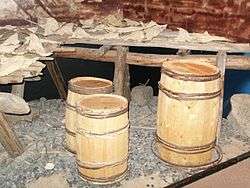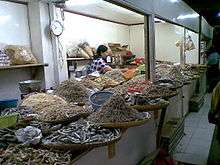Salted fish

Salted fish, such as kippered herring or dried and salted cod, is fish cured with dry salt and thus preserved for later eating. Drying and/or salting, either with dry salt or with brine, was the only widely available method of preserving fish until the 19th century. Dried fish and salted fish (or fish both dried and salted) are a staple of diets in the Caribbean, North Africa, Southeast Asia, Southern China, Scandinavia, coastal Russia, and in the Arctic. Like other salt-cured meats, it provides preserved animal protein even in the absence of electrically powered refrigeration.
Method
Salting is the preservation of food with dry edible salt.[1] It is related to pickling (preparing food with brine, i.e. salty water), and is one of the oldest methods of preserving food.[1] Salt inhibits the growth of microorganisms by drawing water out of microbial cells through osmosis. Concentrations of salt up to 20% are required to kill most species of unwanted bacteria. Smoking, often used in the process of curing meat, adds chemicals to the surface of meat that reduce the concentration of salt required. Salting is used because most bacteria, fungi and other potentially pathogenic organisms cannot survive in a highly salty environment, due to the hypertonic nature of salt. Any living cell in such an environment will become dehydrated through osmosis and die or become temporarily inactivated.
The water activity, aw, in a fish is defined as the ratio of the water vapour pressure in the flesh of the fish to the vapour pressure of pure water at the same temperature and pressure. It ranges between 0 and 1, and is a parameter that measures how available the water is in the flesh of the fish. Available water is necessary for the microbial and enzymatic reactions involved in spoilage. There are a number of techniques that have been or are used to tie up the available water or remove it by reducing the aw. Traditionally, techniques such as drying, salting and smoking have been used, and have been used for thousands of years. In more recent times, freeze-drying, water binding humectants, and fully automated equipment with temperature and humidity control have been added. Often a combination of these techniques is used.[2]
Gallery
-

Platforms, called fish flakes, where cod dry in the sun before being packed in salt
-
Remains of Roman fish-salting plant at Neapolis
-
Drying salted fish at Malpe Harbour
-

Salt fish dip at Jakarta
-

Ruins of the Port Eynon Salt House – seawater was boiled to extract salt for preserving fish
-

Egyptians bringing in fish and splitting them for salting
-

Salted dried fish sold on a Hong Kong street
-

Fish in a salt crust
-

Fish cellars at Church Cove, England, used for pressing salted pilchards into barrels for storage and export to the continent
-

Salt cabin, a small building where fish is salted, in Koserow, Germany
See also
- Cantonese salted fish
- Cured fish
- Brining
- Dried and salted cod, one of the main preserved sources of protein for centuries around the Atlantic nations
- Gibbing
- Pickling salt
- Surströmming (Lightly-salted soured Baltic herring)
Notes
- 1 2 "Historical Origins of Food Preservation." University of Georgia, National Center for Home Food Preservation. Accessed Mat 2012.
- ↑ FAO: Preservation techniques Fisheries and aquaculture department, Rome. Updated 27 May 2005.
References
- Schwartz, RK (2004) "All roads lead to Rome: Roman food production in North Africa" Repast, 20 (4) : 5–6 and 8–9.
| ||||||||||||||||||||||||||||||||||||||||

